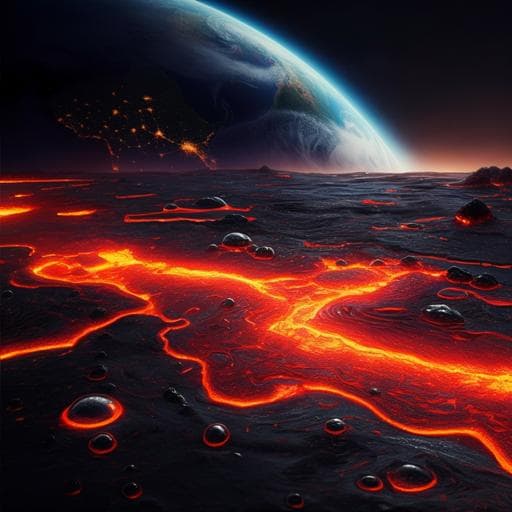
Space Sciences
Degassing of CO₂ triggers large-scale loss of helium from magma oceans
A. H. Davis and R. Caracas
This research by Anne H. Davis and Razvan Caracas reveals that the moon-forming impact led to a carbon-rich and helium-rich atmosphere on early Earth, suggesting a much thicker and hotter world than previously believed. Their findings provide critical insights into our planet's evolution and similar processes on other celestial bodies.
~3 min • Beginner • English
Introduction
Rocky planetary bodies undergo a similar accretion process, yielding common outcomes. Early on, planetesimals cohere into planetary embryos, which, depending on the formation speed and time, may capture helium and hydrogen gas from the solar nebula. Some of these gases are trapped in the interior, while the remainder contributes to primordial atmospheres, which might be partially eroded after dissipation of the nebula. Extensive melting due to accretionary impacts or radiogenic heat results in magma oceans (MO). Volatile elements are continuously delivered to planetary embryos and are subsequently dissolved in magma bodies or outgassed to form secondary atmospheres. Large impacts also cause extensive melting and vaporization, resulting in resets of the atmosphere. For Earth, such an impact led to a protolunar disk, from which the Earth and Moon condensed into MO states. Many volatiles survived the impact and became well mixed within the silicate liquid in the inner parts of the disk. Heavier volatiles, such as noble gases or carbon, became part of the early Earth, either as dissolved species in the MO or as part of the atmosphere. This volatile and silicate-rich atmosphere was thick and insulating, reaching pressures of several kilobars, delaying MO solidification and prolonging MO devolatilization. The devolatilization rate depends on the thermochemical evolution at the MO surface. At first, vaporization was unhindered, but as crystallization advanced, sluggish melt percolation enabled the formation of a surface lid, limiting degassing. Understanding the factors controlling volatile degassing is paramount to constrain the global budget of primitive volatiles and the conditions and timescales under which Earth crystallized. Here, we examine carbon's influence on He degassing from the global MO of the early Earth. We perform ab initio molecular dynamics simulations on pyrolite melt, which reproduces the bulk silicate Earth composition (BSE), to which we have added helium and CO₂ molecules. Noble gases (particularly He) are used to study degassing due to their lack of chemical bonding, which makes them excellent tracers of physical processes. Each noble gas has at least one stable and one radiogenically produced isotope, and the ratios of these isotopes allow us to identify relative ages of degassed source material. Carbon is easily devolatilized, and studies show that CO and CO₂ dominated the early atmosphere. As noble gases were undersaturated in the MO, they could not nucleate bubbles on their own. Instead, they partitioned into bubbles filled with CO₂ or other volatiles. While previous work examined independent helium and carbon vaporization from pyrolite, this is the first study to examine their concurrent vaporization.
Literature Review
The paper situates its study within prior work on magma oceans, volatile delivery and degassing, and early Earth atmospheres. Previous studies indicate that post-impact proto-atmospheres were thick and insulating, dominated by CO and CO₂, and that noble gases act as tracers of degassing due to their chemical inertness. Prior simulations and experiments have separately addressed He solubility and degassing from silicate melts and CO₂ solubility and speciation in melts and glasses, showing Henry’s law behavior at lower pressures and dependence on ionic porosity. Observations and experiments suggest noble gases are undersaturated in MO melts and partition into bubbles nucleated by more soluble volatiles such as CO₂ and H₂O, with correlations between CO₂ and He in natural magmatic systems. Earlier computational work examined He degassing from pyrolite melts and CO₂-rich, H₂O-depleted early atmospheres independently; this study advances the literature by jointly modeling concurrent He and C vaporization to quantify coupled effects on degassing efficiency and speciation.
Methodology
The authors performed ab initio molecular dynamics (AIMD) simulations using VASP with the PAW method and PBE GGA exchange-correlation. The silicate melt is a pyrolite composition (reported stoichiometry NaCa₂Fe4Mg30Al3Si24089) representing bulk silicate Earth to within ~1 wt%. They constructed a 153-atom pyrolite supercell and added four He atoms and four CO₂ molecules (1.4 wt% C, typical of carbonaceous chondrites) to study degassing; He content was intentionally elevated relative to natural abundances to obtain robust statistics. Simulations were run in the NVT ensemble with a Nosé-Hoover thermostat, Gamma-point sampling, plane-wave cutoff 550 eV (800 eV for augmentation charges), time steps of 1–2 fs, and durations of 10–40 ps depending on conditions. Temperatures spanned 2000–5000 K and pressures 0.5–256 kbar to represent early MO to present-day magma conditions. Multiple (≥4) distinct initial configurations were run per P–T condition and averaged to improve sampling.
Nanobubble formation and two-phase coexistence emerge spontaneously in simulations below ~25 kbar. Vapor species identification used bonding-based cluster analysis: atoms in small clusters (≤12 atoms) not bonded to the extended melt network were classified as vapor. For He, which does not form bonds, the authors defined dissolved versus vapor states by He–O coordination inferred from the first minimum of the He–O pair distribution function obtained at high pressure where He is fully dissolved; He with coordination number to O ≤2 was classified as vapor, ≥3 as dissolved. Time-resolved speciation was analyzed every timestep using the UMD package to quantify the residence time of each atom in vapor versus melt, yielding degassing fractions and lifetimes.
Gas-phase pressure within the simulations was estimated using a modified Van der Waals equation, with species-specific parameter a from the CRC Handbook, and gas volumes determined via Bader charge analysis (vacuum assignment) plus molecular volumes. At least six snapshots per run were averaged to obtain representative gas pressures. The authors note systematic pressure offsets typical of DFT-PBE relative to experiment but emphasize that relative pressure comparisons are valid across their simulations. Van der Waals dispersion corrections were tested and found to have minimal effect on vapor abundance and speciation (~6% difference in He vapor at 0.8 kbar), and thus were omitted. Carbon partitioning among bulk, adsorbed (surface-tethered), and vapor phases was determined by analyzing local bonding: non-vapor C bonded via a single anion to the melt network was counted as adsorbed; C with multiple bonds into the network as bulk. This approach yields a lower bound on adsorbed fractions. Uncertainties arise from finite cell size and surface effects inherent to nanoscale liquid–vapor interfaces.
Key Findings
- Nanobubbles form spontaneously below ~25 kbar; at lower pressures, vapor fraction increases and bubbles occupy up to ~64% of the simulation cell volume at 3000 K (largest cell), enhancing degassing pathways.
- Helium degassing strongly increases with decreasing pressure and increasing temperature. At 5 kbar, fractions of He vaporized are ~6% (2000 K), 28% (3000 K), 44% (4000 K), and 53% (5000 K). Below ~1 kbar, He is effectively totally degassed. He vapor lifetimes lengthen at lower pressure (e.g., 32 fs at 0.8 kbar vs 14 fs at 3.8 kbar at 2000 K).
- CO₂ enhances He degassing: at 5 kbar, CO₂ increases He vaporization by ~23% at 3000 K and ~87% at 5000 K compared to carbon-free melts, likely due to increased melt porosity and volatile-stabilized nanobubbles; CO₂ has little effect on He vapor lifetimes.
- Helium solubility obeys Henry’s law below ~10 kbar (linear increase with pressure); absolute solubilities are slightly higher than in simpler silicate melts due to pyrolite’s complexity.
- Carbon degassing also increases with lower pressure and higher temperature. At 5000 K, C vaporization is ~50% at 3.8 kbar but ~18% at 9.9 kbar. At 5 kbar, C vapor increases from ~19% (2000 K) to ~39% (5000 K). Presence of He enhances C degassing (e.g., at 5 kbar, 3000 K: from ~7% to ~34%). Carbon solubility follows Henry’s law below ~10 kbar (2000 K solubilities ~0.3–1.5 wt.% across pressures), consistent with experimental ranges for various melts and glasses at comparable pressures.
- He and C have similar degassing fractions at 2000–3000 K; at higher temperatures and lower pressures, He becomes more volatile than C. At 0.8 kbar, average vapor lifetimes differ markedly: C ~209 fs vs He ~32 fs.
- Carbon vapor speciation is dominated by CO₂ (~70%) and CO (~30%) below ~5 kbar with weak temperature dependence; above ~5 kbar, higher temperature favors CO. CO lifetimes generally exceed CO₂ lifetimes, but the gap narrows with increasing temperature.
- Non-vapor C partitions among bulk melt, adsorbed (surface) species, and vapor with pressure- and temperature-dependent trends: bulk C decreases exponentially with depressurization while adsorbed and vaporized fractions increase; at mid-pressures (3–8 kbar), bulk, adsorbed, and vapor amounts are comparable; at lowest pressures, most non-vapor C is adsorbed due to abundant surface area. He slightly increases adsorbed C and decreases bulk C.
- Extrapolating to MO surface conditions: early post-impact (~5000 K, 5 kbar) degassing is strong (~50% He, ~40% C degassed). At intermediate stages (~3000–4000 K, 3 kbar), slightly more than half of He and C are lost. In late-stage melts (~2000 K, 1 kbar), degassing remains efficient (~65% He, ~70% C), aligning with MORB/felsic degassing estimates (He and CO₂ ~65–95%).
Discussion
The study addresses how coupled volatile chemistry controls degassing from a global magma ocean. First-principles simulations show that the concurrent presence of carbon (as CO₂/CO vapor) and helium mutually enhances devolatilization via volatile-stabilized nanobubbles and increased melt porosity. This mechanism increases helium loss relative to scenarios considering He alone, indicating that the early Earth’s atmosphere would have been more He-rich and carbon-rich, thicker, and hotter than previously inferred. The comparable degassing efficiencies of He and C imply that CO₂-bearing vapor likely acted as a carrier for noble gases, efficiently stripping them from the MO. A greenhouse feedback arises: as pressure drops and temperature decreases during MO cooling, CO₂ degassing increases, which strengthens atmospheric insulation and further prolongs MO solidification, enhancing total volatile loss. The findings suggest upward revisions to Earth’s initial noble gas inventories and ingassing/retention assumptions. The authors note that their nanoscale simulations provide upper bounds on degassing efficiency given assumptions of rapid convection, exposure of melt to low-pressure surface conditions, and growth/coalescence of bubbles to macroscopic sizes. Broader implications extend to exoplanets: carbon-rich systems should experience elevated volatile loss and thick atmospheres with volatile-depleted interiors, while carbon-poor systems may retain more volatiles, cool faster, and solidify earlier.
Conclusion
Concurrent degassing of helium and carbon from pyrolite (BSE-like) melts is strongly controlled by pressure, temperature, and melt composition, with each volatile enhancing the other’s degassing. CO₂ stabilizes nanobubbles and increases melt porosity, substantially elevating He loss; He similarly promotes C vaporization. Both He and C obey Henry’s law behavior below ~10 kbar, and their degassing fractions are similar at lower temperatures, with He becoming more volatile at higher temperatures. These results imply that the early Earth’s atmosphere was thicker, hotter, and richer in CO₂ and noble gases than previously assumed, producing a greenhouse feedback that prolonged magma ocean lifetimes and increased total volatile loss. Consequences include the need to reassess Earth’s noble gas budget (greater early He loss implies larger initial inventories or ingassing), and predictions for exoplanetary atmospheres and interiors depending on bulk carbon abundance. Future work should quantify large-scale bubble dynamics and ascent, convective exposure of melt to surface conditions, interactions with additional volatiles (e.g., H₂O), and integrate degassing with thermal and chemical evolution models to refine global volatile budgets.
Limitations
- Finite simulation cell sizes and large liquid–vapor interfaces introduce surface effects that increase uncertainty in partitioning and vaporization fractions; reported values represent trends and likely upper bounds.
- Helium abundance was increased relative to natural systems to obtain statistical robustness, which may influence absolute solubilities though trends are preserved.
- Identification of adsorbed carbon undercounts cases with multiple bonds to the surface, yielding a lower bound on adsorption.
- Pressures from DFT-PBE are systematically offset from experiment; gas-phase pressures are estimated via a modified Van der Waals EOS and Bader-derived volumes, introducing model dependence.
- Van der Waals interactions were omitted after tests suggested limited impact, but residual errors (~few percent) may persist.
- Simulations capture nanoscale bubble formation; real MO degassing involves macroscopic bubble growth, coalescence, and complex convective transport. Efficiency of bubble ascent and fraction of melt reaching low-pressure surface layers are uncertain, so extrapolations to planetary scale carry uncertainty.
Related Publications
Explore these studies to deepen your understanding of the subject.







